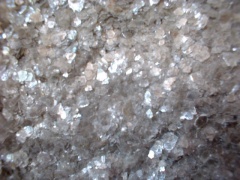Mica
| Infobox on Mica | |
|---|---|
| Example of Mica |  |
| Facts | |
| Origin | - |
| Stowage factor (in m3/t) | - |
| Humidity / moisture | - |
| Ventilation | - |
| Risk factors | - |
Mica
Description / Application
Mica; any of several silicates of varying chemical composition but with similar physical properties and crystalline structure. All characteristically cleave into thin sheets which are flexible and elastic. Synthetic mica is available. It has electrical and mechanical properties superior to those of natural mica; it is also water-free. It is a soft, translucent solid material, non-combustible, heat-resistant. To 600°C, colourless to slight red (ruby), brown to greenish yellow (amber).
Derivation; from muscovite (ruby mica), phlogopite (amber mica), and pegmatite. Synthetic single crystals are ‘grown’ electrothermally.
The mica group of sheet silicate (phyllosilicate) minerals includes several closely related materials having close to perfect basal cleavage. All are monoclinic, with a tendency towards pseudohexagonal crystals, and are similar in chemical composition. The nearly perfect cleavage, which is the most prominent characteristic of mica, is explained by the hexagonal sheet-like arrangement of its atoms.
The word "mica" is derived from the Latin word mica, meaning "a crumb", and probably influenced by micare, "to glitter".
Mica is widely distributed and occurs in igneous, metamorphic and sedimentary regimes. Large crystals of mica used for various applications are typically mined from granitic pegmatites.
Scrap and flake mica is produced all over the world.
The commercially important micas are muscovite and phlogopite, which are used in a variety of applications. Mica’s value is based on several of its unique physical properties. The crystalline structure of mica forms layers that can be split or delaminated into thin sheets usually causing foliation in rocks. These sheets are chemically inert, dielectric, elastic, flexible, hydrophilic, insulating, lightweight, platy, reflective, refractive, resilient, and range in opacity from transparent to opaque. Mica is stable when exposed to electricity, light, moisture, and extreme temperatures. It has superior electrical properties as an insulator and as a dielectric, and can support an electrostatic field while dissipating minimal energy in the form of heat; it can be split very thin (0.025 to 0.125 millimeters or thinner) while maintaining its electrical properties, has a high dielectric breakdown, is thermally stable to 500°C, and is resistant to corona discharge. Muscovite, the principal mica used by the electrical industry, is used in capacitors that are ideal for high frequency and radio frequency. Phlogopite mica remains stable at higher temperatures (to 900 °C) and is used in applications in which a combination of high-heat stability and electrical properties is required. Muscovite and phlogopite are used in sheet and ground forms.
Use: Electrical Equipment, vacuum tubes, incandescent lamps, dusting agent, lubricant, windows in high-temperature equipment, filler in exterior paints, cosmetics, glass and ceramic flux, roofing, rubber, mold-release agent, specialty paper for insulation and filtration, wallpaper and wallboard joint cement, oil-well drilling muds.
Shipment / Storage / Risk factors
Mica
A soft, translucent solid which may be shipped in sheet, powder or crystal form. Must be protected against damage by salt water, as saline destroys the insulating properties of the mica. The cases in which mica in any form is packed should be of sound construction and lined with good quality paper. The wood used in these cases should be well-seasoned, dry and free from stains or traces of mildew, as with variations in climatic conditions, cases may develop heavy mildew, inside and out. Some damage to the contents, mostly at the top and bottom inside surfaces, accompanied by decomposition of the paper linings, may result. This mildewed condition is usually found where no air circulation has been possible. Cross battens on the tops and bottoms of the cases are effective in preventing mildew. Mica waste should be dry at the time of bagging as any moisture rots the bags where they are in contact with each other in stowage, and where air circulation is restricted.
Mica is non-combustible, but loses its natural luster by fire, although it does not char or break. If smoke discolours the surface its commercial value is diminished considerably. When wet by fresh water and the colour of the packing cases penetrates the contents and stains the mica (which may also be integrated with its wrappers), its potential value may suffer but the unaffected portion may be salved by drying the mica by sun heat or in the open air, although this may be a very costly operation.
Mica scrap (In bags)
A mineral like glass that splits easily into sheets. Mica is a soft translucent solid obtained from washing micaceous earth, or grinding rock containing the substance. It is shipped in powder or crystal form and may also be in sheets.
A glass substitute, it is also used in the manufacture of fire-proof paints, asphalt, paper, linoleum and as insulation material. Sulphuric acid is contained in its make up and can cause the packaging (bags) to rot. The decay of the bags may be prevented by providing good ventilation which stowage on pallets assists. Mica talc or white mica is also known as Muscovite or Siberian glass and often shipped from India.
Dust; irritant by inhalation, may be damaging to lungs.
For overseas carriage aspects of Chemicals, the readers are recommended to acquire or have access to a good chemical dictionary. Also consult the applicable MSDS sheet.











